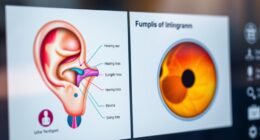Imagine waking up one morning and realizing that your hearing in one ear has suddenly decreased, almost like the volume has been turned down.
This baffling experience could be a result of high blood pressure causing temporary hearing loss. While this connection may seem surprising at first, understanding how hypertension affects the delicate structures in our ears sheds light on this intriguing phenomenon.
Key Takeaways
- High blood pressure damages inner ear structures, leading to temporary hearing loss.
- Monitoring blood pressure levels is crucial for detecting potential hearing impairment.
- Proactive management of hypertension can help prevent temporary hearing loss.
- Temporary hearing loss may serve as an early warning sign of underlying high blood pressure issues.
Understanding the Blood Pressure-Hearing Link
High blood pressure intricately intertwines with hearing health, forming a crucial link that demands understanding to prevent potential auditory complications. The association between hypertension and hearing loss isn't merely coincidental; it stems from the intricate mechanisms within the inner ear. The inner ear is a delicate system responsible for translating sound waves into electrical signals that the brain can interpret.
When high blood pressure exerts excessive force on the blood vessels and nerves within the inner ear, it becomes an accelerating factor of degeneration. This degeneration can lead to temporary hearing loss as the structures essential for auditory function sustain damage. If left unchecked, the impact of high blood pressure on the inner ear can result in permanent hearing impairment, significantly affecting one's quality of life.
Therefore, understanding the relationship between high blood pressure and the degeneration of the hearing structures is paramount in preserving optimal hearing health.
Effects of Hypertension on Hearing

Understanding the intricacies of hypertension's impact on hearing reveals significant correlations between blood pressure levels and auditory function, particularly in relation to hearing threshold levels at varying frequencies. When exploring the effects of hypertension on hearing, several key points come to light:
- Hypertension is linked to an increase in hearing threshold, especially at higher frequencies.
- Individuals with grade 3 hypertension demonstrate a more pronounced elevation in hearing threshold compared to those without hypertension.
- Research shows a clear correlation between hypertension and sensorineural hearing loss.
- Men with hypertension display a more substantial age-related decline in hearing acuity when compared to women.
Regular monitoring of both blood pressure levels and hearing health is vital for the early detection of any negative impact stemming from hypertension on hearing. Intervention strategies can then be implemented promptly to address any potential issues, such as avoiding ototoxic drugs or other detrimental factors that could exacerbate the correlation between hypertension and hearing issues.
The Impact on Temporary Hearing Loss
Temporary hearing loss resulting from high blood pressure manifests as a direct consequence of the damaging effects exerted on the delicate structures within the ear by the intense blood flow associated with hypertension. The high-speed blood flow from elevated blood pressure can harm the intricate blood vessels and nerves in the inner ear, including the fragile eardrum, leading to temporary impairment in hearing.
This temporary hearing loss can occur even before noticeable symptoms of hypertension develop, emphasizing the swift impact of high blood pressure on our auditory system. Monitoring blood pressure levels is crucial to safeguard overall hearing health, as the inner ear's sensitivity to the forceful blood flow highlights the vulnerability of these crucial auditory structures to changes in blood pressure.
Understanding how hypertension affects the delicate organs of the ear underscores the importance of proactive measures in managing blood pressure to prevent temporary hearing issues and preserve our hearing abilities.
Managing Blood Pressure for Hearing Health

Managing blood pressure to support optimal hearing health involves implementing lifestyle changes such as maintaining a balanced diet and engaging in regular exercise. To effectively manage blood pressure and reduce the risk of temporary hearing loss associated with high blood pressure, consider the following:
- Balanced Diet: Consuming a diet rich in fruits, vegetables, whole grains, and lean proteins can promote heart health and help control blood pressure levels.
- Regular Exercise: Engaging in physical activity for at least 150 minutes per week can contribute to overall cardiovascular health, which in turn supports healthy blood pressure.
- Stress Management: Practicing stress-reducing techniques such as meditation, yoga, or deep breathing exercises can help lower blood pressure and minimize its impact on hearing.
- Regular Monitoring: Keeping track of blood pressure readings through home monitoring or regular check-ups with a healthcare provider is essential for early detection and management of hypertension-related hearing issues.
Preventing Temporary Hearing Loss
To prevent temporary hearing loss associated with high blood pressure, vigilantly monitoring blood pressure levels and promptly addressing any fluctuations is crucial. High blood pressure can damage the delicate blood vessels and nerves in the ears, leading to temporary hearing impairment. This can serve as a warning sign of hypertension, making it essential to manage blood pressure through lifestyle changes and medication to prevent such issues.
Sudden spikes in blood pressure from hypertension can cause temporary hearing problems due to increased blood flow in the ear. Regular monitoring of blood pressure and seeking medical advice are vital steps to reduce the risk of temporary hearing loss linked to hypertension. By taking proactive measures to control blood pressure levels, individuals can safeguard their hearing health and potentially avoid the negative impacts of temporary hearing loss caused by high blood pressure.
Frequently Asked Questions
Can You Lose Hearing From High Blood Pressure?
Yes, high blood pressure can lead to hearing loss. The forceful blood flow from hypertension can harm the delicate inner ear structures, causing temporary hearing impairment.
It overwhelms the ear's blood vessels and nerves, accelerating the degeneration of the hearing apparatus. Managing hypertension is crucial for overall hearing health.
Can High Blood Pressure Cause You to Hear Things?
Yes, high blood pressure can cause you to hear things. This phenomenon, known as pulsatile tinnitus, involves hearing rhythmic noises like your heartbeat in the ears.
The increased blood flow and pressure can create these auditory perceptions. It's essential to monitor your blood pressure levels and seek medical advice if you experience this symptom to prevent further hearing issues.
How Bad Is 160 90 Blood Pressure?
High blood pressure reading of 160/90 mm Hg is considered high, indicating hypertension. At this level, the heart and blood vessels are strained, increasing the risk of heart disease and stroke.
Symptoms like dizziness, headache, and vision problems may occur. Proper management is crucial to prevent complications.
Monitoring and lifestyle changes are essential for maintaining optimal health and reducing risks associated with high blood pressure of 160/90 mm Hg.
Why Did I Temporarily Lose My Hearing?
We experienced temporary hearing loss due to various factors like exposure to loud noises, ear infections, or sudden changes in air pressure.
Such issues can affect the delicate structures of the inner ear, hindering our ability to hear properly. Seeking medical evaluation can help identify the root cause and appropriate treatment.
It's essential to address any concerns promptly to prevent further complications and preserve our auditory health.
Conclusion
In conclusion, high blood pressure can act as a turbulent storm, wreaking havoc on the delicate organs of the ear and causing temporary hearing loss.
By navigating the waters of hypertension with proper management and seeking medical guidance, we can steer clear of the rocky shores of hearing impairment.
Let's chart a course towards healthier blood pressure levels to ensure smooth sailing for our precious auditory senses.











